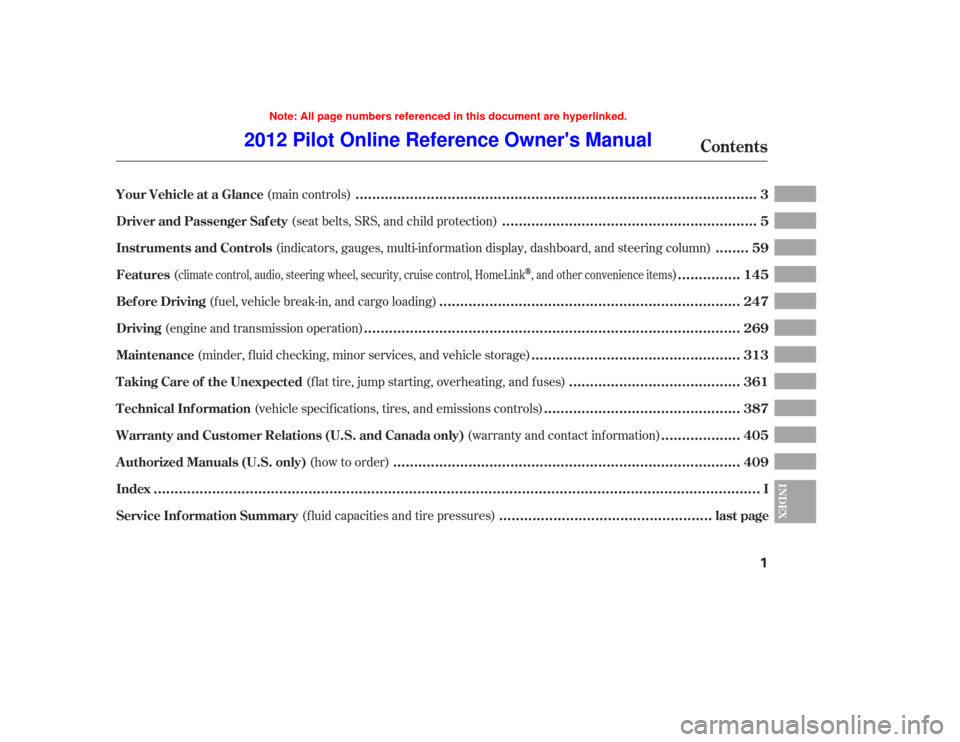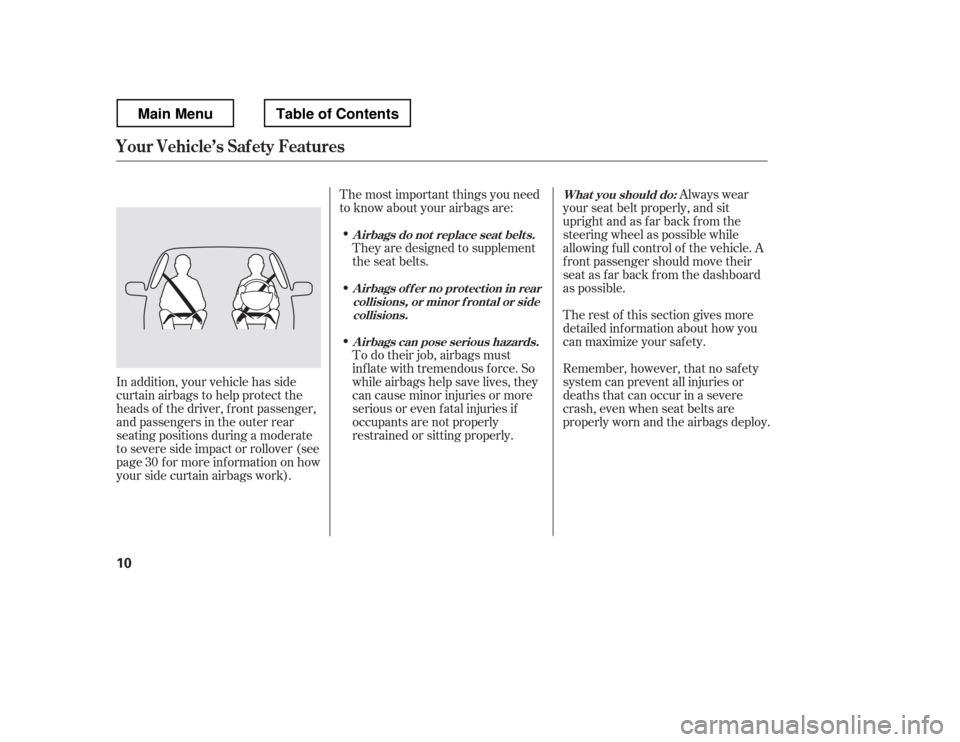Page 8 of 429

(f luid capacities and tire pressures)
(seat belts, SRS, and child protection)
(main controls)
(indicators, gauges, multi-inf ormation display, dashboard, and steering column)
(fuel, vehicle break-in, and cargo loading)
(
)
(engine and transmission operation) (minder, f luid checking, minor services, and vehicle storage)
(f lat tire, jump starting, overheating, and f uses)
(vehicle specif ications, tires, and emissions controls)
(warranty and contact inf ormation)
(how to order)
climate control, audio, steering wheel, security, cruise control, HomeLink, and other convenience items
Contents
................................................................................................................................................
Index .I
..................................................
Service Inf ormation Summary . last page
............................................................
Driver and Passenger Saf ety .5
...............................................................................................
Your Vehicle at a Glance .3
.......
Instruments and Controls .59
.......................................................................
Bef ore Driving .247
..............
Features .145
.........................................................................................
Driving .269
.................................................
Maintenance .313
........................................
T aking Care of the Unexpected .361
..............................................
T echnical Inf ormation .387
..................
Warranty and Customer Relations (U.S. and Canada only) . 405
..................................................................................
A uthorized Manuals (U.S. only) .409INDEX
1
Note: All page numbers referenced in this document are hyperlinked.
2012 Pilot Online Reference Owner's Manual
Page 9 of 429
How to operate the heating and air
conditioning system, the audio
system, and other convenience
f eatures.
A convenient ref erence to the
sections in this manual.
A quick ref erence to the main
controls in your vehicle.
Explains the purpose of each
instrument panel indicator and gauge,
and how to use the controls on the
dashboard and steering column.
The proper way to start the engine,
shif t the transmission, and park; plus
what you need to know if you
Page 17 of 429

The rest of this section gives more
detailed inf ormation about how you
can maximize your saf ety.
The most important things you need
to know about your airbags are:
They are designed to supplement
the seat belts.
Remember, however, that no saf ety
system can prevent all injuries or
deaths that can occur in a severe
crash, even when seat belts are
properly worn and the airbags deploy.Always wear
your seat belt properly, and sit
upright and as f ar back f rom the
steering wheel as possible while
allowing f ull control of the vehicle. A
f ront passenger should move their
seat as far back from the dashboard
as possible.
To do their job, airbags must
inf late with tremendous f orce. So
while airbags help save lives, they
can cause minor injuries or more
serious or even fatal injuries if
occupants are not properly
restrained or sitting properly.
In addition, your vehicle has side
curtain airbags to help protect the
heads of the driver, f ront passenger,
and passengers in the outer rear
seating positions during a moderate
to severe side impact or rollover (see
page f or more inf ormation on how
your side curtain airbags work).
30
Your Vehicle
Page 21 of 429
If you sit too close to the steering
wheel or dashboard, you can be
seriously injured by an inf lating f ront
airbag, or by striking the steering
wheel or dashboard.Adjust the driver
Page 45 of 429

�µ
During a crash, the
belt could press deep into the child
and cause serious or fatal injuries.
If they do, they
could be very seriously injured in a
crash. Children who play in vehicles
can accidentally get trapped inside.
Teach your children not to play in
or around vehicles. Know how to
operate the emergency In-Bed
Trunk opener and decide if your
children should be shown how to
use this f eature (see page ).
Opening or
closing the tailgate could cause
accidental injuries.
Even very young
children learn how to unlock
vehicle doors, turn on the ignition
switch, and open the windows,
which can lead to accidental injury
or death.
If you are not wearing a
seat belt in a crash, you could be
thrown f orward and crush the
child against the dashboard or a
seat-back. If you are wearing a
seat belt, the child can be torn
f rom your arms and be seriously
hurt or killed.
If a child wraps a loose seat belt around their neck, they
can be seriously or f atally injured.
(See pages and f or how to
activate and deactivate the
lockable retractor.)
Leaving children without
adult supervision is illegal in most
states, Canadian provinces and
territories, and can be very
hazardous. This can prevent
children f rom accidentally f alling
out (see page ).
For example, infants and small
childrenleftinavehicleonahot
day can die f rom heatstroke. A
child lef t alone with the key in the
ignition switch can accidentally set
the vehicle in motion, possibly
injuring themselves or others. 46 47
104 117
Additional Saf ety Precautions
Protecting Children General Guidelines
Never put a seat belt over yourself
and a child.
Never let two children use thesame seat belt . L ock all doors and t he In-Bed
T runk when your vehicle is not in use.
T each your children not t o play onthe pickup bed.
K eep vehicle keys/remot etransmitters out of the reach of children.
Neverholdaninfantorchildon
your lap.
Make sure any unused seat beltt hat a child can reach is buckled,the lockable retractor is activated,and the belt is f ully retracted andlocked. Do not leave children alone in a
vehicle.
Use t he childproof door locks t o
prevent children f rom opening t herear doors.
38
Table of ContentsMain Menu
Page 63 of 429
These labels are in the locations
shown. They warn you of potential
hazards that could cause serious
injury or death. Read these labels
caref ully.
If a label comes of f or becomes hard
to read (except for the U.S.
dashboard label which may be
removed by the owner), contact your
dealer f or a replacement.U.S. modelsCanadian models
U.S. models only
U.S. models only
Saf ety L abels
56
RADIATOR CAPDASHBOARD
SUN VISORSUN VISORS
Table of ContentsMain Menu
Page 81 of 429
This indicator reminds you that the
bed lights are on. With the shif t lever
in the Park position, they come on
when you push the light switch on
the dashboard, swing open the
tailgate, or open the In-Bed Trunk.If you turn the ignition switch to the
ACCESSORY (I) or LOCK (0)
position without turning of f the bed
lights, this indicator will remain on,
andthengooff after20minutes.See
page f or more inf ormation.
Most of the time, this indicator
comes on along with other indicators
in the instrument panel such as the
seat belt reminder indicator, SRS
indicator, VSA system indicator, etc.
This indicator comes on when there
is a system message on the multi-
inf ormation display. Press the INFO
button on the dashboard (see page
) to see the message (see page).
82
90 144On models with navigation system
Bed L ights On Indicator
Message Indicator
Instrument Panel Indicators
74
Main MenuTable of Contents
Page 89 of 429
�Û�Ý
�Û�Ý
�Û
�ÝWith the ignition switch in the ON
(II) position, the multi-inf ormation
display changes as shown on the
next page each time you press the
INFO ( / ) button or the SEL/
RESET button.
When you turn the ignition switch to
the ON (II) position, your last
selection is displayed.
The multi-inf ormation display in the
instrument panel displays various
inf ormation and messages when the
ignition switch is in the ON (II)
position. Some of the messages help
you operate your vehicle more
comf ortably. Others help to keep
you aware of the periodic
maintenance your vehicle needs f or
continued trouble-f ree driving.
To change the display, press the
INFO( / )buttononthe
dashboard repeatedly until the main
menu appears (see page ).
When you open the driver